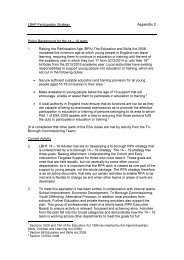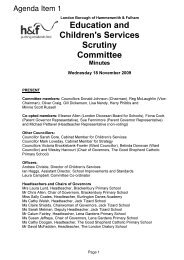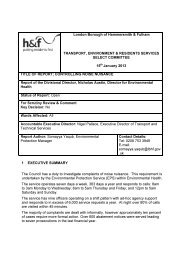DRAFT Pending approval by relevant Health and Wellbeing Boards
DRAFT Pending approval by relevant Health and Wellbeing Boards
DRAFT Pending approval by relevant Health and Wellbeing Boards
You also want an ePaper? Increase the reach of your titles
YUMPU automatically turns print PDFs into web optimized ePapers that Google loves.
APPENDIX 1<br />
<strong>DRAFT</strong><br />
<strong>Pending</strong> <strong>approval</strong> <strong>by</strong> <strong>relevant</strong><br />
<strong>Health</strong> <strong>and</strong> <strong>Wellbeing</strong> <strong>Boards</strong><br />
A Review of Employment Support for<br />
People with Mental Illness, Physical<br />
Disabilities <strong>and</strong> Learning Disabilities<br />
EXECUTIVE SUMMARY<br />
Tri-Borough Joint Strategic Needs<br />
Assessment (JSNA)<br />
August 2013<br />
Website: www.jsna.info
Employment Support Joint Strategic Needs Assessment<br />
EXECUTIVE SUMMARY<br />
Purpose of this<br />
document<br />
Burden of illness<br />
<strong>and</strong> economic<br />
inactivity<br />
This document reports the needs assessment <strong>and</strong> service mapping of local <strong>and</strong> national<br />
specialist employment support for Tri-borough residents with mental illness, physical<br />
<strong>and</strong> learning disabilities. The report also reviews the evidence of best practice <strong>and</strong><br />
outlines the vision for a new evidence-based service.<br />
Across the Tri-borough area, there are high levels of economic inactivity, particularly in<br />
relation to mental illness <strong>and</strong> physical disabilities.<br />
Nationally, mental health conditions are the most common reason for people to be<br />
dependent on health-related benefits (3). Tri-borough rates of severe mental illness<br />
(SMI) are among the highest in London <strong>and</strong> Engl<strong>and</strong>. Local levels of Incapacity Benefit<br />
(IB) <strong>and</strong> Employment Support Allowance (ESA) claims due to mental ill-health are also<br />
high compared to London, particularly in Hammersmith <strong>and</strong> Fulham (8 th highest in<br />
London). Paid employment rates for clients with severe mental illness in Kensington<br />
<strong>and</strong> Chelsea (K&C) <strong>and</strong> Westminster are below the London <strong>and</strong> Engl<strong>and</strong> averages. This<br />
is despite the fact that nationally up to 90% of all mental health service users want to<br />
work (1) <strong>and</strong> at least a third of those currently unemployed due to SMI would like to find<br />
work (4).<br />
Rates of physical disabilities are also high in parts of the Tri-borough area compared to<br />
London, with large numbers of IB <strong>and</strong> ESA claims for physical ill-health in these areas.<br />
Hammersmith <strong>and</strong> Fulham (H&F) has particularly high levels (12 th highest in London).<br />
The numbers of people with learning disabilities are low in the Tri-borough area <strong>and</strong><br />
employment rates are on a par with London levels. However, clients with learning<br />
disabilities have worse employment prospects than other disability groups. The current<br />
employment rate for disabled people nationally has risen to 48% overall but remains<br />
only 10% for those with learning disabilities (6). We know that 65% of people with<br />
learning disabilities nationally would like a paid job (6).<br />
Sickness absence <strong>and</strong> presenteeism (reduced productivity at work related to ill health)<br />
are also likely to have major impacts in the Tri-borough area, based on what we know<br />
nationally (7). Based on population size, sickness absence is estimated to cost the Triborough<br />
economy £84 million per annum in employer costs, health <strong>and</strong> social care costs<br />
<strong>and</strong> welfare (8). Mental illness is the number one cause of long-term sickness absence,<br />
closely followed <strong>by</strong> musculoskeletal problems (9).<br />
Not all people with severe mental health conditions want to be employed, but almost all want to<br />
‘work’, that is to be engaged in some kind of valued activity that meets the expectations of others.<br />
DWP <strong>and</strong> Department of <strong>Health</strong> joint commissioning guidance 2006 (2)<br />
JSNA<br />
Tri-Borough Joint Strategic Needs Assessment Report 2013 2
Employment Support Joint Strategic Needs Assessment<br />
Costs of<br />
economic<br />
inactivity<br />
The impacts of economic inactivity are felt <strong>by</strong> individuals, communities, employers, local<br />
authorities <strong>and</strong> the NHS.<br />
Unemployed individuals have a higher risk of poor physical <strong>and</strong> mental health compared<br />
with those in employment. The health <strong>and</strong> social impacts of a long period of<br />
unemployment can last for years (10).<br />
<strong>Health</strong> inequalities are closely linked to worklessness <strong>and</strong> its links to physical <strong>and</strong> mental<br />
health <strong>and</strong> wellbeing (10, 11). Both unemployment <strong>and</strong> mental illness impact on other<br />
wider determinants of health such as income <strong>and</strong> secure housing, <strong>and</strong> also affect the<br />
wellbeing of families <strong>and</strong> communities<br />
Unemployed people have higher levels of GP consultations <strong>and</strong> longer in-patient stays<br />
(3). Extrapolating from national figures, the cost of mental illness locally is<br />
approximately £300 million in H&F, £250 million in K&C <strong>and</strong> £350 million in<br />
Westminster. Over a third of this is due to loss of economic output (over £80million per<br />
borough) <strong>and</strong> a fifth due to health <strong>and</strong> social care costs (over £5million per borough) (3).<br />
These figures are probably underestimates due to high local prevalence of severe<br />
mental illness <strong>and</strong> a larger working age population than the national average.<br />
Evidence-based<br />
employment<br />
interventions<br />
Evidence-based employment interventions can deliver jobs, improve health <strong>and</strong><br />
wellbeing <strong>and</strong> generate substantial cost savings to local commissioners.<br />
There is substantial evidence that specialist employment support, tailored to the needs<br />
of clients with mental illness or disabilities, can deliver jobs. The most cost effective<br />
models of support include Individual Placement <strong>and</strong> Support (IPS) for mental health<br />
clients <strong>and</strong> Supported Employment (SE) in the disabilities field.<br />
There is also evidence to support a role for ‘Very Supported’ employment opportunities<br />
(such as social enterprises) for clients with very complex needs.<br />
In addition, Government policy advocates early intervention in-work support to help<br />
individuals to retain employment, to prevent the ‘revolving door’ of sickness absence<br />
<strong>and</strong> to avoid the negative health impacts of unemployment (3, 9).<br />
Evidence shows that these approaches to employment support can deliver:<br />
• Improved individual health <strong>and</strong> wellbeing<br />
• Increased personal income<br />
• Reduced use of health <strong>and</strong> social care services<br />
Action on unemployment for these client groups is aligned with national policy on<br />
Welfare to Work <strong>and</strong> helps deliver expectations in the NHS <strong>and</strong> Adult Social Care<br />
Outcomes Frameworks (12, 13). Issues related to employment are part of <strong>Health</strong> <strong>and</strong><br />
<strong>Wellbeing</strong> Board priorities in all three boroughs.<br />
JSNA<br />
Tri-Borough Joint Strategic Needs Assessment Report 2013 3
Employment Support Joint Strategic Needs Assessment<br />
Costs Savings<br />
Evidence-based employment support is, at least, cost neutral. At best it can generate<br />
significant cost savings to local commissioners.<br />
Summary of evidence for cost saving<br />
• A number of IPS trials found up to 50% reductions in health <strong>and</strong> social care costs (1).<br />
• IPS reduces the need for <strong>and</strong> length of hospital stays (1, 3). A multi-site European<br />
r<strong>and</strong>omized trial found that IPS delivered saving of around £6,000 per client in<br />
inpatient psychiatric care costs, compared to usual care (1).<br />
• Social Return on Investment analysis has shown returns of between £5 <strong>and</strong> £13 for<br />
each £1 invested Supported Employment for clients with disabilities (5).<br />
Mapping services<br />
The JSNA team has undertaken an extensive mapping of existing local employment<br />
support for people with mental illness <strong>and</strong> disabilities.<br />
Local specialist employment support was mapped using data from: contract monitoring,<br />
email <strong>and</strong> telephone interviews with national <strong>and</strong> local providers, Co-production<br />
meetings with local service users <strong>and</strong> providers <strong>and</strong> other service user feedback.<br />
There are four national schemes available, 14 locally commissioned providers funded<br />
specifically for tailored employment support to the client groups, <strong>and</strong> over 30 other<br />
voluntary sector providers working with these clients.<br />
Pathways within the service are complex. There is no single point of referral <strong>and</strong> silo<br />
working between providers means that there are major issues around communication.<br />
It is likely that overlaps in provision may also occur.<br />
Current good practice – The mapping identified some areas of excellent practice,<br />
particularly where evidence-based approaches were being pursued. Feedback from Coproduction<br />
meetings was positive about the increasing numbers of professionals with<br />
underst<strong>and</strong>ing of mental health issues.<br />
Interviewing people at the day service, or other friendly <strong>and</strong> accessible facility works well<br />
Service user at Coproduction meeting<br />
Spend – The majority of spending is on mental health, which reflects the greater<br />
numbers of mental health clients in the Tri-borough, compared to the number of people<br />
with disabilities. However, spend <strong>by</strong> borough is not always allocated according to need.<br />
Westminster currently spends much less than other boroughs on support for clients with<br />
mental illness, despite having a significantly higher burden of these conditions;<br />
Kensington <strong>and</strong> Chelsea spends the most.<br />
JSNA<br />
Tri-Borough Joint Strategic Needs Assessment Report 2013 4
Employment Support Joint Strategic Needs Assessment<br />
Gaps in provision of services for specific client groups were identified <strong>and</strong> are already<br />
being addressed. For example, Hammersmith <strong>and</strong> Fulham is currently working to fill its<br />
gap in provision of specialist support for clients with physical disabilities.<br />
JSNA<br />
Tri-Borough Joint Strategic Needs Assessment Report 2013 5
Employment Support Joint Strategic Needs Assessment<br />
Stages of support – There are gaps in provision of some stages of employment support.<br />
In particular, there is significant need for in-work support both for clients getting jobs<br />
through specialist local support <strong>and</strong> for employed people struggling in work with<br />
common mental illnesses <strong>and</strong> musculoskeletal problems.<br />
Outcomes – It is clear that some providers are achieving a far smaller number of<br />
outcomes for the money received compared to others. This will need to be investigated<br />
further to underst<strong>and</strong> underlying reasons, as there may be legitimate reasons for this.<br />
Limitations of the mapping <strong>and</strong> subsequent data analysis come from gaps in the data<br />
<strong>and</strong> inconsistent terminology. Providers use different definitions of interventions (e.g.<br />
what constitutes in-work support) <strong>and</strong> outcomes (e.g. what constitutes a job outcome).<br />
Many providers do not routinely collect details of jobs obtained or impacts on health<br />
<strong>and</strong> wellbeing. Comparisons of provider performance are further complicated <strong>by</strong> their<br />
clients having different levels of need.<br />
National provision<br />
There have been developments in national provision, with increased focus on<br />
supporting clients challenged in the open job market. However, national evidence has<br />
identified major issues for all four national programmes around their ability fully to meet<br />
the needs of clients with mental illness <strong>and</strong> disabilities.<br />
JobCentre Plus (JCP) is the first point of contact for any client claiming benefits <strong>and</strong><br />
offers generic employment support with some specialist provision for clients with health<br />
problems. However, a national review identified that JCP staff may have ‘poor<br />
awareness of mental health issues’ (4). Co-production feedback identified that service<br />
users felt that JCP advisers were not always trained to support people with disabilities,<br />
particularly in communicating with clients with learning disabilities.<br />
The Work Programme is the Government’s flagship Welfare to Work programme <strong>and</strong> is<br />
being delivered in West London <strong>by</strong> three Prime contractors. Started in 2011, it aims to<br />
support clients with additional barriers to work, including claimants of Employment<br />
Support Allowance (health-related) <strong>and</strong> Job Seekers Allowance (not health-related).<br />
There are concerns that current early performance is not yet up to the levels expected.<br />
The Public Accounts Committee described one-year performance as ‘disappointing’.<br />
Overall outcomes were worse than previous programmes <strong>and</strong> considerably lower than<br />
DWP expectations (14). Clients with a disability were half as likely to have a job<br />
outcome as people without a disability. London performed worse for disabilities clients<br />
than the rest of the UK (15). However, there is considerable national <strong>and</strong> local<br />
commitment to improve on this early performance.<br />
Work Programme Primes don't offer enough support for people with complex needs.<br />
Co-production group feedback<br />
The two schemes designed specifically for clients with registered disabilities (Work<br />
Choice <strong>and</strong> Access to Work grants) are not available to clients already on the Work<br />
Programme. Furthermore, Work Choice requires clients to be able to work for 16 hours<br />
per week (16) which excludes many people with disabilities. A major national review<br />
JSNA<br />
Tri-Borough Joint Strategic Needs Assessment Report 2013 6
Employment Support Joint Strategic Needs Assessment<br />
found that Access to Work is underused, particularly <strong>by</strong> clients with mental illness <strong>and</strong><br />
learning disabilities (17).<br />
Economic climate<br />
Under the current economic climate <strong>and</strong> with reforms to welfare, investment in<br />
employment support is an even greater priority.<br />
During an economic downturn, the job market is challenging, particularly to clients with<br />
disabilities <strong>and</strong> mental illness (where the prevalence increases during periods of<br />
recession (10)). With reforms to benefits, there is likely to be in influx of clients into the<br />
job market who have previously been considered ‘too ill to work’. Employment support<br />
providers are likely to face additional challenges in successfully supporting clients into<br />
jobs at this time. However, if provision of employment support were reduced, the<br />
resultant impacts on individuals will ultimately be passed onto NHS <strong>and</strong> local authorities<br />
with increased use of services (3).<br />
A future service<br />
Local employment support provision is to be recommissioned <strong>by</strong> Adult Social Care <strong>and</strong><br />
NHS Mental <strong>Health</strong> commissioners.<br />
The JSNA has identified some key aims for a new service, based on local <strong>and</strong> national<br />
findings. Commissioners may want to consider the following:<br />
1. To maximise the effectiveness of existing national provision<br />
There is scope for better partnership work (including delivery of mental health<br />
<strong>and</strong> disabilities awareness training) <strong>and</strong> improved referral pathways between<br />
local <strong>and</strong> national providers.<br />
2. To commission evidence-based specialist employment support for<br />
clients not eligible for national schemes <strong>and</strong> for those whose needs are<br />
not currently being fully met <strong>by</strong> national provision<br />
3. To integrate in-work support as a key element of the specialist<br />
employment support service<br />
4. To commission an early intervention in-work support service across the<br />
Tri-borough councils<br />
JSNA<br />
Tri-Borough Joint Strategic Needs Assessment Report 2013 7
Employment Support Joint Strategic Needs Assessment<br />
REFERENCES<br />
1. Parsonage M. Commissioning what works: the economic <strong>and</strong> financial case for<br />
supported employment: Sainsbury Centre for Mental <strong>Health</strong>; 2009.<br />
2. DWP, <strong>Health</strong> Do, Programme NSI, NIMHE, CSIP. Vocational services for people<br />
with severe mental health problems: Commissioning guidance. 2006.<br />
3. London Mental <strong>Health</strong> <strong>and</strong> Employment Partnership. Work, Mental <strong>Health</strong> <strong>and</strong><br />
Welfare:The case for co-ordinated action to achieve shared benefit.<br />
http://www.londonhp.nhs.uk/wp-content/uploads/2012/09/LHP-case-foraction.pdf2012.<br />
4. Thomas T, Ryan T, Newbigging K. SEU consultation exercise. Mental health,<br />
illness <strong>and</strong> social exclusion (<strong>Health</strong> <strong>and</strong> Social Care Advisory Service). 2004.<br />
5. Wilkins A, Love B, Greig R, Bowers H. Economic evidence around employment<br />
support: scoping review. London: National Institute for <strong>Health</strong> Research. 2012.<br />
6. Department of <strong>Health</strong>. Valuing employment now: real jobs for people with<br />
learning disabilities: Great Britain. Department of <strong>Health</strong>; 2009.<br />
7. Black DC. Working for a healthier tomorrow. 2008.<br />
8. Centr for Mental <strong>Health</strong>.<br />
http://www.centreformentalhealth.org.uk/employment/presenteeism.aspx.<br />
accessed2013.<br />
9. Black, Frost. <strong>Health</strong> at Work - an independent review of sickness absence. 2011.<br />
10. UCLInstituteof<strong>Health</strong>Equity, Network ftLHI. The impact of the economic<br />
downturn <strong>and</strong> policy changes on health inequalities in London. 2012.<br />
11. Waddell G, Burton K. Is work good for your health <strong>and</strong> well-being? Independent<br />
report commissioned <strong>by</strong> DWP. 2006.<br />
12. Department of <strong>Health</strong>. The NHS Outcomes Framework 2013/14. 2013/14.<br />
13. Department of Healt. The Adult Social Care Outcomes Framework 2013/14.<br />
2013/14.<br />
14. Public Accounts Committee. DWP: Work Programme Outcome Statistice. 2013.<br />
15. GLA Intelligence. The Work Programme - Job Outcome Statistics. 2012.<br />
16. DWP. Eligibility criteria for Work Choice - https://www.gov.uk/workchoice/eligibility<br />
Website accessed April 2013.<br />
17. Sayce. Getting in, staying in <strong>and</strong> getting on: disability employment support fit for<br />
the future. 2011.<br />
JSNA<br />
Tri-Borough Joint Strategic Needs Assessment Report 2013 8

















